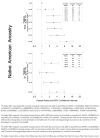The influence of genetic ancestry and ethnicity on breast cancer survival associated with genetic variation in the TGF-β-signaling pathway: The Breast Cancer Health Disparities Study
- PMID: 24337772
- PMCID: PMC3946243
- DOI: 10.1007/s10552-013-0331-9
The influence of genetic ancestry and ethnicity on breast cancer survival associated with genetic variation in the TGF-β-signaling pathway: The Breast Cancer Health Disparities Study
Abstract
The TGF-β signaling pathway regulates cellular proliferation and differentiation. We evaluated genetic variation in this pathway, its association with breast cancer survival, and survival differences by genetic ancestry and self-reported ethnicity. The Breast Cancer Health Disparities Study includes participants from the 4-Corners Breast Cancer Study (n = 1,391 cases) and the San Francisco Bay Area Breast Cancer Study (n = 946 cases) who have been followed for survival. We evaluated 28 genes in the TGF-β signaling pathway using a tagSNP approach. Adaptive rank truncated product (ARTP) was used to test the gene and pathway significance by Native American (NA) ancestry and by self-reported ethnicity (non-Hispanic white (NHW) and Hispanic/NA). Genetic variation in the TGF-β signaling pathway was associated with overall breast cancer survival (P ARTP = 0.05), especially for women with low NA ancestry (P ARTP = 0.007) and NHW women (P ARTP = 0.006). BMP2, BMP4, RUNX1, and TGFBR3 were significantly associated with breast cancer survival overall (P ARTP = 0.04, 0.02, 0.002, and 0.04, respectively). Among women with low NA, ancestry associations were as follows: BMP4 (P ARTP = 0.007), BMP6 (P ARTP = 0.001), GDF10 (P ARTP = 0.05), RUNX1 (P ARTP = 0.002), SMAD1 (P ARTP = 0.05), and TGFBR2 (P ARTP = 0.02). A polygenic risk model showed that women with low NA ancestry and high numbers of at-risk alleles had twice the risk of dying from breast cancer as did women with high NA ancestry. Our data suggest that genetic variation in the TGF-β signaling pathway influences breast cancer survival. Associations were similar when the analyses were stratified by genetic ancestry or by self-reported ethnicity.
Figures
Similar articles
-
Associations between genetic variants in the TGF-β signaling pathway and breast cancer risk among Hispanic and non-Hispanic white women.Breast Cancer Res Treat. 2013 Sep;141(2):287-97. doi: 10.1007/s10549-013-2690-z. Epub 2013 Sep 14. Breast Cancer Res Treat. 2013. PMID: 24036662 Free PMC article.
-
Energy homeostasis genes and survival after breast cancer diagnosis: the Breast Cancer Health Disparities Study.Cancer Causes Control. 2016 Jan;27(1):47-57. doi: 10.1007/s10552-015-0681-6. Cancer Causes Control. 2016. PMID: 26472474 Free PMC article.
-
Matrix metalloproteinase genes are associated with breast cancer risk and survival: the Breast Cancer Health Disparities Study.PLoS One. 2013 May 16;8(5):e63165. doi: 10.1371/journal.pone.0063165. Print 2013. PLoS One. 2013. PMID: 23696797 Free PMC article.
-
Genetic polymorphisms in the transforming growth factor-beta signaling pathways and breast cancer risk and survival.Methods Mol Biol. 2009;472:265-77. doi: 10.1007/978-1-60327-492-0_11. Methods Mol Biol. 2009. PMID: 19107437 Review.
-
Landmark Series: The Cancer Genome Atlas and the Study of Breast Cancer Disparities.Ann Surg Oncol. 2023 Oct;30(11):6427-6440. doi: 10.1245/s10434-023-13866-w. Epub 2023 Aug 16. Ann Surg Oncol. 2023. PMID: 37587359 Review.
Cited by
-
Interaction between common breast cancer susceptibility variants, genetic ancestry, and nongenetic risk factors in Hispanic women.Cancer Epidemiol Biomarkers Prev. 2015 Nov;24(11):1731-8. doi: 10.1158/1055-9965.EPI-15-0392. Epub 2015 Sep 12. Cancer Epidemiol Biomarkers Prev. 2015. PMID: 26364163 Free PMC article.
-
Literature review of data-based models for identification of factors associated with racial disparities in breast cancer mortality.Health Syst (Basingstoke). 2018 Mar 11;8(2):75-98. doi: 10.1080/20476965.2018.1440925. eCollection 2019. Health Syst (Basingstoke). 2018. PMID: 31275571 Free PMC article. Review.
-
Variability in Cancer Risk and Outcomes Within US Latinos by National Origin and Genetic Ancestry.Curr Epidemiol Rep. 2016;3:181-190. doi: 10.1007/s40471-016-0083-7. Epub 2016 Jun 30. Curr Epidemiol Rep. 2016. PMID: 27547694 Free PMC article. Review.
-
Relationship between West African ancestry with lung cancer risk and survival in African Americans.Cancer Causes Control. 2019 Nov;30(11):1259-1268. doi: 10.1007/s10552-019-01212-z. Epub 2019 Aug 29. Cancer Causes Control. 2019. PMID: 31468279 Free PMC article.
-
Response to Conner et al. Re: "Cigarette Smoking and Breast Cancer Risk in Hispanic and Non-Hispanic White Women: The Breast Cancer Health Disparities Study".J Womens Health (Larchmt). 2017 Jan;26(1):92-93. doi: 10.1089/jwh.2016.6292. Epub 2017 Jan 4. J Womens Health (Larchmt). 2017. PMID: 28051904 Free PMC article. No abstract available.
References
-
- Gordon KJ, Blobe GC. Role of transforming growth factor-beta superfamily signaling pathways in human disease. Biochim Biophys Acta. 2008;1782(4):197–228. - PubMed
-
- Wharton K, Derynck R. TGFbeta family signaling: novel insights in development and disease. Development. 2009;136(22):3691–3697. - PubMed
-
- Buck MB, Knabbe C. TGF-beta signaling in breast cancer. Annals of the New York Academy of Sciences. 2006;1089:119–126. - PubMed
-
- Blyth K, Cameron ER, Neil JC. The RUNX genes: gain or loss of function in cancer. Nat Rev Cancer. 2005;5(5):376–387. - PubMed
-
- Lee KS, Hong SH, Bae SC. Both the Smad and p38 MAPK pathways play a crucial role in Runx2 expression following induction by transforming growth factor-beta and bone morphogenetic protein. Oncogene. 2002;21(47):7156–7163. - PubMed
Publication types
MeSH terms
Substances
Grants and funding
- CA77305/CA/NCI NIH HHS/United States
- CA078682/CA/NCI NIH HHS/United States
- R01 CA078552/CA/NCI NIH HHS/United States
- HHSN261201000036C/CA/NCI NIH HHS/United States
- R01 CA078762/CA/NCI NIH HHS/United States
- 1U58 DP000807-01/DP/NCCDPHP CDC HHS/United States
- R01 CA140002/CA/NCI NIH HHS/United States
- R01 CA063446/CA/NCI NIH HHS/United States
- CA078552/CA/NCI NIH HHS/United States
- N01-PC-67000/PC/NCI NIH HHS/United States
- CA078802/CA/NCI NIH HHS/United States
- U58 DP000807/DP/NCCDPHP CDC HHS/United States
- R01 CA078802/CA/NCI NIH HHS/United States
- R01 CA078682/CA/NCI NIH HHS/United States
- CA14002/CA/NCI NIH HHS/United States
- CA078762/CA/NCI NIH HHS/United States
LinkOut - more resources
Full Text Sources
Other Literature Sources
Medical


